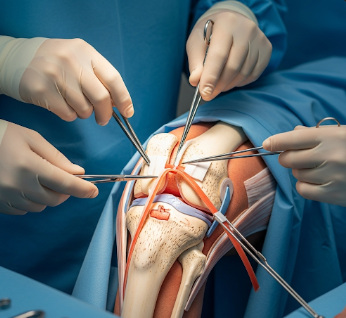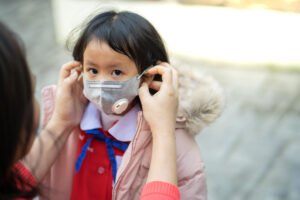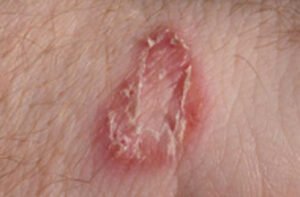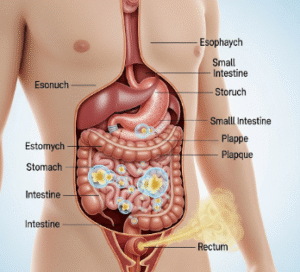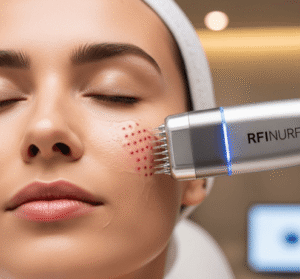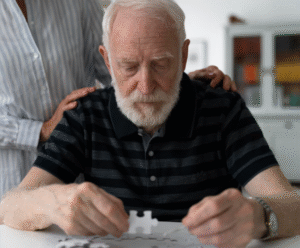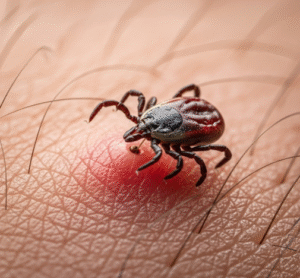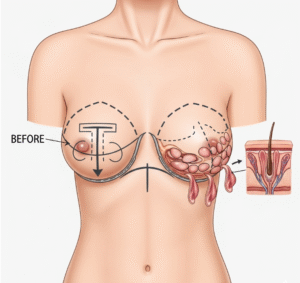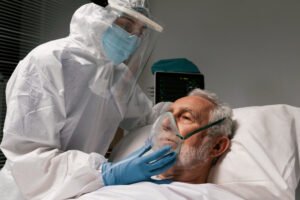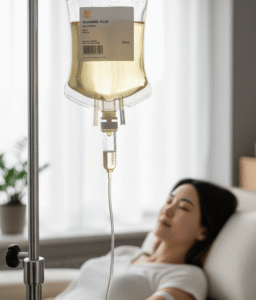What It Is
The anterior cruciate ligament (ACL) is one of the most important ligaments in the knee joint. It runs diagonally in the middle of the knee and plays a vital role in stabilizing the knee, preventing the shinbone (tibia) from sliding forward on the thighbone (femur), and controlling rotational movements.
An ACL injury occurs when the ligament is stretched or torn, usually due to sports that involve sudden stops, pivots, or awkward landings. Once torn, the ACL does not heal naturally, which is why surgical intervention is often required for active individuals.
ACL surgery (also called ACL reconstruction) involves replacing the torn ligament with a graft, typically made from the patient’s own tendon (autograft) or a donor tendon (allograft). Instead of repairing the damaged ligament directly, the procedure reconstructs the ligament with new tissue that gradually adapts and functions like the original ACL.
ACL surgery is one of the most common orthopedic procedures worldwide, especially among athletes and active individuals. With advances in arthroscopic (minimally invasive) techniques, outcomes are excellent, allowing many patients to return to competitive sports and active lifestyles.
Why It’s Done
An ACL tear significantly affects knee stability and function. Without proper treatment, the knee may feel unstable, leading to repeated injuries and early-onset arthritis.
ACL surgery is recommended when:
- Athletes and sports enthusiasts want to return to high-demand activities such as soccer, basketball, skiing, or martial arts.
- Knee instability interferes with daily life — patients may feel their knee “gives way” during walking, climbing stairs, or even turning suddenly.
- Combined injuries are present — ACL tears are often accompanied by meniscus tears, cartilage damage, or injury to other ligaments.
- Young and active patients are at risk of long-term joint damage if the ACL is not reconstructed.
Benefits of ACL surgery include:
- ➤ Restoration of knee stability and confidence in movement.
- ➤ Prevention of further injuries to cartilage and meniscus caused by repeated instability.
- ➤ Safe return to sports and physical activity, often at pre-injury performance levels.
- ➤ Lower risk of early osteoarthritis, which is common after untreated ACL injuries.
- ➤ Improved quality of life, allowing normal participation in work, recreation, and sports.
Alternatives
While surgery is the gold standard for active patients, non-surgical options may be appropriate in selected cases:
- ➤ Physical Therapy & Rehabilitation: Strengthening surrounding muscles (quadriceps, hamstrings) can compensate for the torn ACL. Some patients achieve good stability without surgery.
- ➤ Knee Bracing: Functional braces provide external support, useful for low-impact activities but not reliable for pivoting sports.
- ➤ Lifestyle Modification: Patients unwilling to undergo surgery may choose to avoid high-risk sports and stick to low-impact activities such as swimming, cycling, or walking.
- ➤ Partial Activity Adjustments: Older adults or sedentary individuals may function reasonably well without surgery if knee instability is mild.
⚠️ However, non-surgical management has limitations. Many patients eventually develop instability episodes, cartilage wear, or meniscus damage, prompting them to reconsider surgery.
Preparation
Proper preparation is critical to maximize surgical success and recovery:
- ✅ Clinical Evaluation: Includes physical examination, medical history, and imaging tests (X-rays, MRI). MRI confirms ACL tear and evaluates associated injuries.
- ✅ Prehabilitation (“Prehab”): Strengthening exercises before surgery help reduce swelling, restore motion, and improve post-surgery outcomes.
- ✅ Medical Clearance: Patients undergo blood tests, heart checkups, and anesthesia evaluation.
- ✅ Fasting: Required before surgery if general anesthesia is used.
- ✅ Medication Management: Blood thinners, certain anti-inflammatories, or supplements may need to be stopped.
- ✅ Home & Support Planning: Patients arrange crutches, a knee brace, and home assistance, especially for the first 1–2 weeks after surgery.
How It’s Done
ACL surgery is almost always performed arthroscopically (keyhole surgery), using small incisions and a camera-guided scope. This minimizes tissue damage, reduces scarring, and speeds recovery.
Step-by-step process:
- Anesthesia: General or regional anesthesia ensures the patient feels no pain.
- Incisions: Tiny cuts are made to insert an arthroscope and surgical instruments.
- Joint Inspection: The surgeon examines the knee, confirms the ACL tear, and treats associated injuries (meniscus repair, cartilage smoothing).
- Removal of Torn ACL: The remnants of the damaged ligament are cleared.
- Graft Harvesting:
- Autograft: Tendon taken from the patient’s hamstring, quadriceps, or patellar tendon.
- Allograft: Tendon from a donor (cadaver).
- Tunnel Creation: Small bone tunnels are drilled in the tibia and femur to anchor the new ligament.
- Graft Placement: The graft is threaded through the tunnels and secured with screws or fixation devices.
- Closure: The incisions are closed with sutures or medical glue.
Duration: About 1–2 hours.
Hospital Stay: Many patients go home the same day; some stay 1 night.
Recovery
Recovery is structured and lengthy, but outcomes are excellent with proper rehabilitation.
Immediate Post-Surgery (Weeks 1–2):
- ✔️ Rest, ice, compression, elevation (RICE) to reduce swelling.
- ✔️ Use of crutches and knee brace.
- ✔️ Gentle range-of-motion exercises under physiotherapist guidance.
Early Recovery (Weeks 3–6):
- ✔️ Gradual increase in weight-bearing.
- ✔️ Strengthening exercises for quadriceps and hamstrings.
- ✔️ Stationary cycling and light exercises begin.
Intermediate Recovery (Weeks 7–16):
- ✔️ Progressive strengthening, balance training, and endurance.
- ✔️ Jogging on even surfaces by 3–4 months.
- ✔️ Sports-specific drills without contact.
Advanced Recovery (Months 6–12):
- ✔️ Agility training, pivoting, and jumping exercises.
- ✔️ Gradual return to competitive sports, often 9–12 months after surgery.
Return to Sports Timeline:
- 3–4 months: Jogging, low-impact activities.
- 6 months: Non-contact drills, light sports practice.
- 9–12 months: Full return to competitive sports, if cleared by surgeon.
⚠️ Rehabilitation is as important as the surgery itself. Poor compliance with physiotherapy greatly increases the risk of re-injury.
Possible Complications
While ACL reconstruction has a high success rate (>90%), potential complications include:
- ⚠️ Infection (rare, <1%) – requires antibiotics or surgical cleaning.
- ⚠️ Blood clots (DVT) – prevented with early mobility.
- ⚠️ Stiffness or Loss of Motion – minimized with aggressive physiotherapy.
- ⚠️ Graft Failure or Re-tear – can occur if the knee is injured again before full healing.
- ⚠️ Knee Pain or Weakness – especially at graft harvest site (patellar tendon).
- ⚠️ Hardware Problems – screws or fixation devices may cause irritation, occasionally requiring removal.
Treatment Options in Korea
South Korea is globally recognized for orthopedic excellence and advanced sports medicine, making it a top destination for ACL surgery and rehabilitation.
- 🏥 Leading Hospitals: Seoul National University Hospital, Asan Medical Center, Samsung Medical Center, and specialized orthopedic clinics are renowned for ACL reconstruction.
- 🏥 Arthroscopic & Robotic Techniques: Korean surgeons use state-of-the-art minimally invasive and navigation-assisted methods.
- 🏥 Expertise with Athletes: Many Korean orthopedic surgeons treat professional athletes, ensuring world-class outcomes.
- 🏥 Advanced Rehabilitation Programs: Hospitals provide structured physiotherapy, including hydrotherapy, motion analysis, and sports-specific rehab.
- 🏥 Medical Tourism: International patients benefit from English-speaking coordinators, affordable surgery packages, and integrated care.
- 🏥 Cost Efficiency: ACL surgery in Korea costs 40–60% less than in the US or Europe while maintaining high quality and short waiting times.
Highlights
- ➤ ACL surgery reconstructs torn knee ligaments with tendon grafts.
- ➤ Indicated for athletes, active patients, and those with unstable knees.
- ➤ Performed arthroscopically with high success rates.
- ➤ Recovery takes 6–12 months with structured rehabilitation.
- ➤ Complications are rare but may include infection, stiffness, or graft failure.
- ➤ Korea offers cutting-edge orthopedic care at affordable prices, with outstanding rehab programs.

